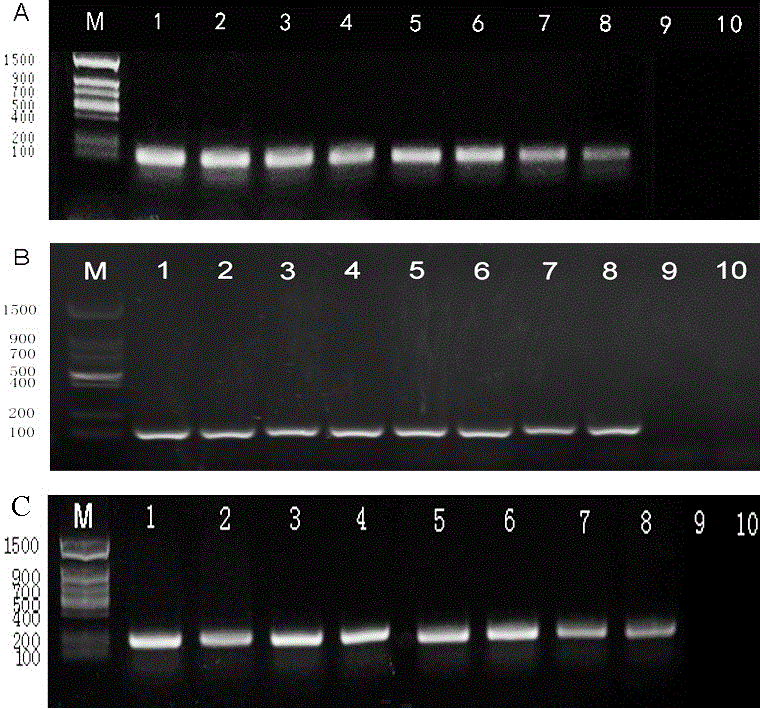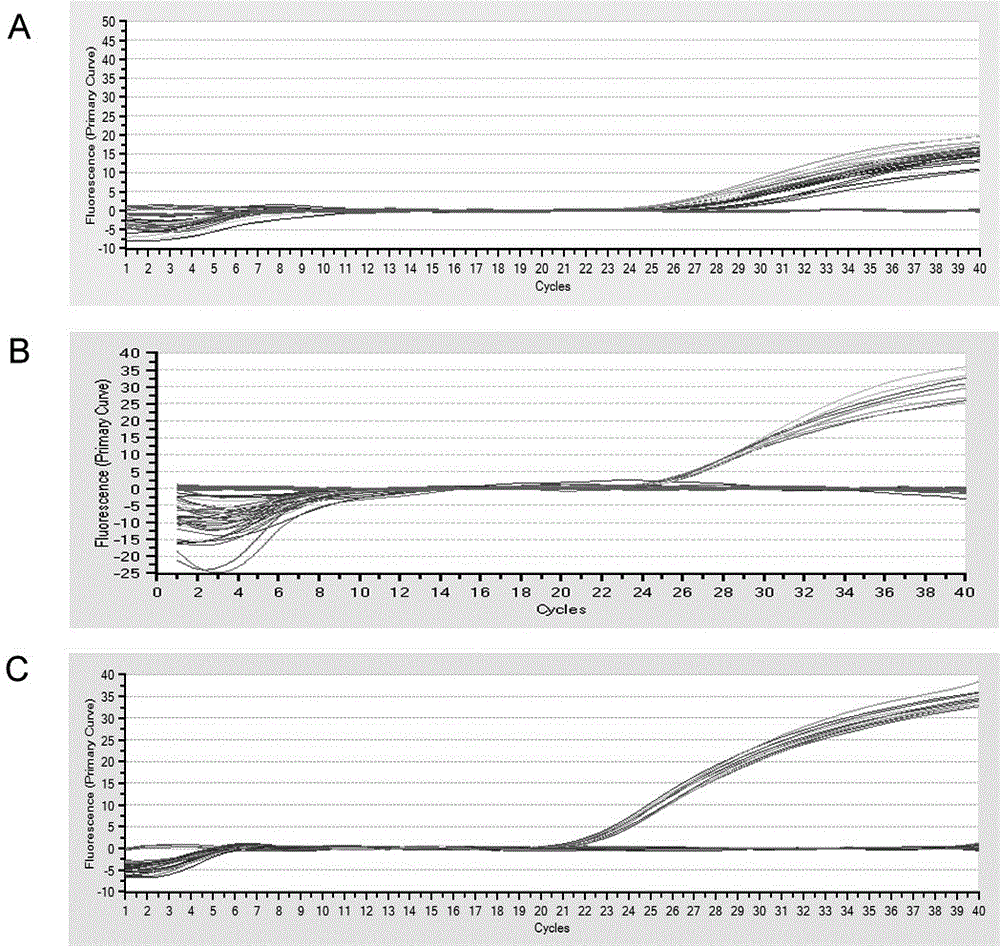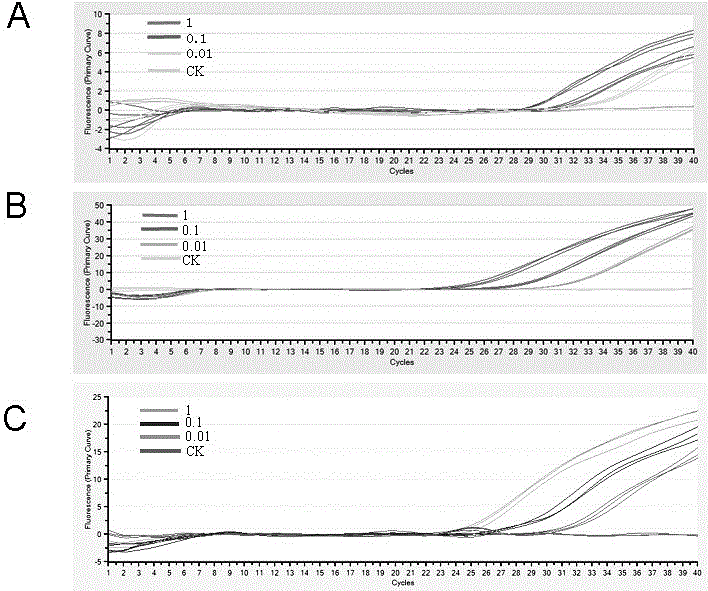Real-time fluorescence quantification PCR primers and probes for identifying three kinds of pratylenchus coffeae on sugarcane and kit thereof
A real-time fluorescent quantitative, short-bodied nematode technology, applied in biochemical equipment and methods, microbial determination/inspection, DNA/RNA fragments, etc., can solve problems affecting sugarcane yield and quality, and achieve high sensitivity and good application. Foreground effect
- Summary
- Abstract
- Description
- Claims
- Application Information
AI Technical Summary
Problems solved by technology
Method used
Image
Examples
Embodiment 1
[0042] Example 1 Primer probe design and reaction condition optimization
[0043] 1. Primer design
[0044] (1) The primer set qYF2 / qYR2, the specific probe qYP, and the primer set qNF for Brachybody zea zea were designed according to the DNA ITS sequences of Brachybody zea zea, Brachybody zea pseudonym and other plant-parasitic nematodes in NCBI / qNP, specific probe qNP. As shown in Table 1.
[0045] (2) According to the mitochondrial DNA of short-tailed brevis and other plant-parasitic nematodes in NCBI COI Sequence designed the primer set qBF2 and qBR1, and the specific probe qBP. As shown in Table 1.
[0046] Table 1 Primers and probes
[0047]
[0048] 2. Optimization of primer reaction conditions
[0049] (1) Using a single nematode DNA of Brachybody zea zea, Brachybody zea pseudonym, and Brachybody zeatrix as templates, PCR amplification was performed at different annealing temperatures, and the annealing temperature of the above primer sets was optimized.
...
Embodiment 2
[0057] Example 2 specific detection
[0058] 1. According to the primers and probes designed in Example 1, the real-time fluorescent quantitative PCR method for detecting Brachybody zea zea, Brachybody zea pseudomaize and the shortest-tailed Brachybody worm respectively has been established:
[0059] The real-time fluorescent quantitative PCR reaction system is: 2 μL DNA, 0.4 μL (10 μM) of upstream and downstream primers, 0.4 μL (10 μM) of probe, 10 μL real-time fluorescent quantitative PCR premix reagent and the balance of ddH 2 O, a total of 20 μL.
[0060] The real-time fluorescent quantitative PCR reaction conditions of B. maize and B. maize were as follows: pre-denaturation at 95°C for 30 s; 95°C for 5 s, annealing temperature at 60°C for 35 s, a total of 40 cycles;
[0061] The real-time fluorescent quantitative PCR reaction conditions of the short-tailed Brachyphyta nematode were as follows: pre-denaturation at 95°C for 30 s; 95°C for 5 s, annealing at 55°C for 35 s an...
Embodiment 3
[0073] Embodiment 3 detection sensitivity and standard curve
[0074] 1. Under the stereoscope, pick 1 Brachybody zea zea, 1 Brachybody zea pseudonym, and 1 short-tail Brachybody nematode respectively, extract DNA according to the above method, and then carry out gradient dilution on the DNA samples ( as shown in Table 3).
[0075] Table 3 Concentrations of DNA samples used to make the standard curve and the corresponding Ct values
[0076]
[0077] 2. Using the above-mentioned DNA samples of various dilution concentrations as templates, perform real-time fluorescent quantitative PCR amplification respectively, and the PCR reaction system and conditions are the same as those in Example 2.
[0078] 3. The results are attached image 3 As shown, there is a good linear relationship when amplifying 0.01-1 target nematode, indicating that the system can accurately quantify the number of nematodes in the sample.
[0079] In addition, the above results also show that the real-t...
PUM
 Login to View More
Login to View More Abstract
Description
Claims
Application Information
 Login to View More
Login to View More - R&D
- Intellectual Property
- Life Sciences
- Materials
- Tech Scout
- Unparalleled Data Quality
- Higher Quality Content
- 60% Fewer Hallucinations
Browse by: Latest US Patents, China's latest patents, Technical Efficacy Thesaurus, Application Domain, Technology Topic, Popular Technical Reports.
© 2025 PatSnap. All rights reserved.Legal|Privacy policy|Modern Slavery Act Transparency Statement|Sitemap|About US| Contact US: help@patsnap.com



